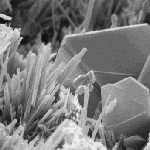
Vehicle Exhaust CO2 Capture and Soil Storage Promoting Plant Growth by carboncapture&cultivate
 Jennifer Lawrence Dec 30, 2014 09:38 |
Thank you for this proposal. The creativity here is exactly what we are looking for.
You mentioned MIT as one space that could use this idea. Are there other areas where this will be effective, based on the heat maps, or satellite images you have seen?
My one suggestion on this proposal is for you to respond to the rest of the questions set forth in the contest before February 6th - otherwise it looks sound. Moving forward, you may get questions from some of the scientists on our team.
Thank you!
Jen
|
 Kenneth D. Murray Jan 5, 2015 08:29 | Proposal contributor
Jen,
Thank you for the comment. I am filling-in almost daily, adding, and so forth. What you mention is a good point and I think the concept will fit the heat and prevailing wind maps. There is some cooling isolation over MIT campus, and at surrounding high tech buildings bordering the campus. If studied more closely, and with perhaps an experiment, I could make a more specific statement based on data.. For now I can say, if I had 2-digital thermometers, and on a sunny day placed one on the white roof of MIT Offices, Mass. Ave., and one on top of the black asphalt roof adjacent, the readouts would be significantly different.
..and so it goes.
Regards,
Ken
|
 Jennifer Lawrence Jan 6, 2015 02:47 |
Thank you, Ken! Your proposal is filling out quite well.
Jen
|
 Konstantin Lackner Jan 22, 2015 04:46 |
Hey Ken, great idea! Concerning the asphalt roof tops: There's an initiative in Chicago to build green roof tops (I suggest for the same reason as in this contest). Here you can have a look at it: http://www.artic.edu/webspaces/greeninitiatives/greenroofs/main.htm
Maybe it helps as inspiration :)
|
 Michael Hayes Jan 30, 2015 07:06 |
Hi Ken,
Your proposal is a good, well rounded, collection of ideas and I would like to offer a few comments as a light weight form of collaboration. Clearly, your past work on these issues has gained you the respect of the Mayor and many local environmental actors and I, being an outsider, simply can not compete with both your local knowledge and acceptance.
As I'm sure everyone at the community action level understands, getting the City a win on the Georgetown Energy Challenge should be a strong priority as the prize money would obviously open many technological paths. The proposals within this MIT Climate Colab Challenge should be weighed heavily on the specific subject of the need "...to reduce America’s energy consumption" value so as to potentially help the City win.
My comments/suggestions on your proposal are:
1) It's great to see the inclusion of biochar in your proposal. The fastest way we have to a negative carbon emissions scenario is through the use of biochar and liquid biofuels. This is the basic logic behind the strong IPCC (WG 3) support for 'Bio-Energy with Carbon Capture and Sequestration' (BECCS). The upstream supply of biomass is the primary limiting factor for BECCS and cities have huge biomass potential within their sewage systems through using the nutrients within the sludge to cultivate micro-algae.
This cycling of sewage nutrients into both liquid fuel and biochar can be a true win-win scenario for cities as the fuel can be used to run city vehicles/power plants with excess fuel being sold for the cash revenues. The biochar can be used in the city through pasture cropping methods and the excess biochar being sold off to the agro community for additional profits. These important benefits are compounded further if one considers that such use of the sewage waste stream would significantly reduce the cost of treatment/discharge...and...the limiting of the environmental damage that comes with discharging, even treated waste, in the water ways.
However, large scale operation of photosynthetic algae tanks are currently not a realistic urban option for a number of obvious reasons. The limitations of providing artificial lighting and or large surface area cultivation tanks for natural lighting being the prime limiting factors. There is simply no room for such operations and, understandably, folks simply will not want the smell.
Thus, we need a way around photosynthesis. The oxyhydrogen reaction in microalgae offers such an option which allows the cultivation of algae within dark reactors which are as simple as water pipelines and other simple vessels.
In looking over the documents provided for this challenge, there appears to be a significant amount of new waterlines being planed for just south of Fresh Pond and that work could easily incorporate a dark cultivation pipeline network placed next to the standard water pipes. Also, this combined approach to sewage management/bio-fuel production/carbon negative enhancement (i.e. biochar) can be the foundation for a....safe...low pressure city wide hydrogen fuel distribution network as dark cultivation of algae uses hydrogen and the dark cultivation network could be tapped into for this hydrogen for home/city/industry energy needs.
In brief, there are no complicated details concerning the biochar/bio-fuel based negative carbon emission scenario and the oxyhydrogen reaction in algae (the complex side) is not that difficult to understand and is safe use.
http://jgp.rupress.org/content/26/2/241.full.pdf+html
Most importantly, using sewage for biofuel/biochar production (the carbon negative/BECCS scenario) can be viewed as both a reduction in overall energy use and a system which (per Georgetown) "Highlight best practices for communities working with utilities, businesses, and their local governments to create and implement inventive plans for sustained energy efficiency".
2) Your support for green roofs/walls etc. is highly supportable and well stated. I see the Copenhagen Green Roof protocol as a much needed national/global standard.
http://inhabitat.com/copenhagen-adopts-a-mandatory-green-roof-policy/
2) The thermal glass shielding of walkways/streets is an idea which will be useful for many communities...which can afford them. These glass canopies would also be a prime location for cold water misting units for those days which pose critical health concern conditions, as well as, possible utility runs. As the canopies will be a large capital expense, designing in as many ancillary functions as possible is obviously important.
Enclosing multi-modal walkways and roadways, with a combination of technologies including utility runs, can be a significant economic savings for the community, as well as, environmentally sound. Such a combination would represent a 'Multiplexed' roadway as opposed to a multi-modal roadway. The roadway designers and city utilities designers need to start talking and listening to each other on the potential synergies available in designing for multiplexed systems. Clearly, room is under utilized in the roadway systems.
If we simply had 3 runs of 5' dia. dual walled HDPE culvert pipelines running along under or above each roadway we would have:
a) ample room for biomass/bio-fuel production which would provide-
b) the fuel we need for transport and industry in general-
c) a means to capture the CO2 emissions pumped down from the enclosed roadway ventilation system-
d) a means to process our sewage and thus avoid discharging into the environment
e) cargo hyperloops (pneumatic transport tubes) to move bulk commodities
f) easy repair/upgrade of all systems
g) the under roadway variant offers substantial geothermal energy potential which, combined with biomass production, makes such multiplexed systems potentially net energy producers while operating at a net negative carbon emissions level (biochar being an export commodity by-product of the biomass production).
The above list of benefits is not exhaustive.
Glassed in, green roofed/walled multiplexed walkways/roadways with biomass production means would seem to offer savings for all concerned budgets. A synergistic analysis of the combined city budget for roadways, water/sewage lines and bio-energy/energy savings needs, using not multi-modal but...multiplexed....walkways/streets could be an interesting exercise.
3) Few people know about Heron's pump and I was impressed that you brought it to the table. I've often wondered what benefits we would have if the Heron Pump were to be mated to the Water Ram. There is nothing restricting the two working together to provide a highly reliable, although low efficient, combined energy conversion/storage system.
https://www.google.com/search?q=water+ram&es_sm=93&tbm=isch&tbo=u&source=univ&sa=X&ei=Du7LVL6BJpHYoAShq4KwAw&ved=0CFsQsAQ&biw=1366&bih=667
The ability of the Water Ram to produce significant pressure can be used, in a stepped fashion, to pump water up to any roof. However, the ram needs an ability to sluff off a good deal of the intake water and thus the reservoir and return pumping provided by the Heron might be usefully linked.
In brief, Herons typically lack high pressure output where as Rams, which has high pressure output, need a return pump/reservoir. This combination may or may not be useful but it is fun to mentally dink around with.
4) Your inclusion of water filtration is welcomed and the type of filtration, such as aquaponics, can feed into the need for biomass production. One idea concerning combining urban water filtration/aquaponics is to incorporate the aquaponics into covered road/walk ways and or green roof greenhouses, which many have recommended, yet focus upon non-eatable plants with extremely high CO2 uptake rates. Giant Bamboo has an almost scary growth rate (CO2 uptake) and offers a number of synergistic down stream benefits.
http://www.lewisbamboo.com/growth-chart.html
I would like to add to this water related subject the need for the cultivation of beneficial aquatic animals such as rotifers (http://en.wikipedia.org/wiki/Rotifer) and copepods (http://en.wikipedia.org/wiki/Copepod) as many urban lakes/ponds have become so contaminated with heavy metals that these animals, which are vital to natural water filtration and biotic health, have been stressed to the point of reproductive failure.
The cultivation of both species can be incorporated into aquaponics operations and the animals transferred to the open water sites until the lake/pond water quality improves enough for natural regeneration.
5) The call for thermophotonics is much in line with the call for the use of the emissive energy harvesting (EEH) technology.
http://www.pnas.org/content/111/11/3927.short
I've always been amazed at the call for more and more energy when we are awash in energy and our growing problem is getting rid of it! The use of thermophotonics/EEH like energy management systems need to be central in all urban planning efforts.
Large scale energy storage is also an important energy related need and the use of organic flow batteries is safe to use on a city wide scale and easy to design into many of the structural elements under review. The turnip enzymes needed for such batteries can be produced within the local gardens. This would be a great K-12 project to get the kids interested in both biology and energy management. Thus, this aspect keys into the third Georgetown objective.
6) Terra Preta will be one of the main downstream outputs of a sewage based biomass/biofuel/biochar production system. Also, the importance of including olivine dust into the biochar/organic fertilizer has become evident as the olivine feeds the soil mycorrhiza which, in turn, feeds the plants the minerals provided by the olivine. Electron microscopic studies found this important link this last year (or two).
When we get into the details of this overall area of interest, that of olivine/biochar/organic fertilizers, I like to point out a new technology which cities can use as both a means for dispersing of these biologically important commodities but also kill off weeds along roadways and other landscape sites instead of using chemical agents.
The USDA is investing in the development of sandblasting gear which uses organic fertilizer as the weed whacking abrasive. I've emailed the developers and asked that olivine and biochar be included in the abrasive fertilizer. If we can find a way to collect the proper mycorrhiza spores and throw them into the abrasive/fertilizer sandblasting mix, terra preta would be as common as...dirt!
http://www.northcentralsare.org/Newsroom/Regional-News-and-Press-Releases/Researcher-Uses-Sandblasting-for-Weed-Control
7) The only word of caution I would like to offer is related to the wide spread use of lime. The caustic nature of quick lime may represent an issue for the water filtration/biotic city systems.
In all, your work is excellent and I would like to hear more of your thoughts on the type of organization you would recommend be created to help manage this effort. I hope that my effort at this collaborative exchange has been of some use to you and I do truly hope we can continue this exchange in the future.
Best regards,
|
 Kenneth D. Murray Feb 1, 2015 01:34 | Proposal contributor
Hi Michael,
Thank you. Your comments and suggestions are appreciated. They imply possible collaborative effort be created. Time may not allow it in this regard, but a continued exchange is recommended.
Further discussion in another note will follow this one.
Best regards
|
 Kenneth D. Murray Feb 6, 2015 05:04 | Proposal contributor
Michael: Your comments and Suggestions are Greatly Appreciated - Please find below inserted -in bold- additional detail from me... more later.
The proposals within this MIT Climate Colab Challenge should be weighed heavily on the specific subject of the need "...to reduce America’s energy consumption" value
Large scale operation of photosynthetic algae tanks are currently not a realistic urban option for a number of obvious reasons. The limitations of providing artificial lighting and or large surface area
Your proposal is a good, well rounded, collection of ideas and I would like to offer a few comments as a light weight form of collaboration. Clearly, your past work on these issues has gained you the respect of the Mayor and many local environmental actors and I, being an outsider, simply can not compete with both your local knowledge and acceptance.
As I'm sure everyone at the community action level understands, getting the City a win on the Georgetown Energy Challenge should be a strong priority as the prize money would obviously open many technological paths. The proposals within this MIT Climate Colab Challenge should be weighed heavily on the specific subject of the need "...to reduce America’s energy consumption" value so as to potentially help the City win.
My comments/suggestions on your proposal are:
1) It's great to see the inclusion of biochar in your proposal. The fastest way we have to a negative carbon emissions scenario is through the use of biochar and liquid biofuels. This is the basic logic behind the strong IPCC (WG 3) support for 'Bio-Energy with Carbon Capture and Sequestration' (BECCS). The upstream supply of biomass is the primary limiting factor for BECCS and cities have huge biomass potential within their sewage systems through using the nutrients within the sludge to cultivate micro-algae.
Carbon capture methods are found in nature. Carbon dioxide (CO2), the primary greenhouse gas is a naturally captured component of "acid rain" Atmospheric CO2 dissolves easily in the cold water of rain and falls on exposed mafic and ultra-mafic mine tailings in Northern Canada.. Researchers there recently found anthropogenic CO2 derived carbonic acid falling onto Mg-, Ca-, Na-, K- containing SiO2 rocks forming carbonate which locks the molecule into solid materials (for examples, CaCO3, MgCO3).
http://www.czen.org/content/atmospheric-co2-sink-silicate-weathering-or-carbonate-weathering
For Bio-Energy, a process to accelerate this "weathering" and "capture" "combustion by-product CO2" is entirely available for testing if anyone is interested, please contact me (kennethdmurray@gmail.com -or- Linked-In).
Also, the captured CO2 can be reused for additional algae growth by slight pH adjustment. Cultured algae require more dissolved CO2 than most aquatics contain. To remedy, the conventional method is to bubble-in cylinder CO2 gas - a processed liquid, very expensive.
Murray
|
 Kenneth D. Murray Feb 6, 2015 05:07 | Proposal contributor
Michael: Your comments and Suggestions are Greatly Appreciated - Please find below inserted -in bold- additional detail from me... more later.
Carbon capture methods are found in nature. Carbon dioxide (CO2), the primary greenhouse gas is a naturally captured component of "acid rain" Atmospheric CO2 dissolves easily in the cold water of rain and falls on exposed mafic and ultra-mafic mine tailings in Northern Canada.. Researchers there recently found anthropogenic CO2 derived carbonic acid falling onto Mg-, Ca-, Na-, K- containing SiO2 rocks forming carbonate which locks the molecule into solid materials (for examples, CaCO3, MgCO3).
http://www.czen.org/content/atmospheric-co2-sink-silicate-weathering-or-carbonate-weathering
For Bio-Energy, a process to accelerate this "weathering" and "capture" "combustion by-product CO2" is entirely available for testing if anyone is interested, please contact me (kennethdmurray@gmail.com -or- Linked-In).
Also, the captured CO2 can be reused for additional algae growth by slight pH adjustment. Cultured algae require more dissolved CO2 than most aquatics contain. To remedy, the conventional method is to bubble-in cylinder CO2 gas - a processed liquid, very expensive.
Murray
|
 Michael Hayes Feb 10, 2015 05:16 |
Hello Murray,
On the mineral weathering issue, I'm most familiar with the works of Prof. Olaf Schuiling (https://www.google.com/webhp?sourceid=chrome-instant&ion=1&espv=2&ie=UTF-8#q=prof%20olaf%20schuiling) and an AGU poster of his can be found at (https://drive.google.com/file/d/0B4dTSYGhZ8XnSHcwUXRzLWJEZzA/view?usp=sharing).
He has been kind enough to give me guidance on many issues concerning the weathering of olivine and it looks like the reference you offered falls within his scope of work. Thank you for the paper and I'll keep it in my notes.
On the comment of "accelerate weathering, capture biofuel combustion exhaust CO2 and then reuse it as aquaculture growth amendment", I'm not understanding the link between mineral weathering and biofuel. Obviously both belong in a well rounded protocol yet they are, in the order you've stated, of different regiments.
The reuse of biofuel CO2 emissions is understandable with the only limitation being the size of the algal aquaculture operation being large enough to utilize the full CO2 flow. Also, the drop in pH when using a forced flow of CO2 would need to be mitigated which is something olivine is good at (as well as providing micro nutrients). So, in a round about way, yes, I do know about the importance of minerals and particularly in the BECCS cycle.
Further, the CO2 emissions can also be converted for water pH adjustment using the method developed by Dr. Greg Rau et. al.;
http://dge.stanford.edu/labs/caldeiralab/Caldeira_research/Rau_Knauss.html in which the end product would provide pH adjustment.
I agree with your comment of "conventional wisdom bubbles-in cylinder CO2 gas - a processed liquid, very expensive." and I believe that the best path around that expense is through the direct use of CO2 emissions with continuous pH adjustment.
All of the above has been in discussion within a number of different forums (for some time) and the overall methodology of looping the CO2 from biofuel emissions to micro-algae cultivation tanks and back is well understood. However, there is a need to take carbon out of the loop and that is achieved with the production of biochar.
The pyrolysis of biomass is the most environmentally accepted way of taking carbon out of the loop as it not just provides a usable energy conversion (electrical production) but also provides biochar, which, as you know, when used in the soil offers multi-year CO2 sequestration means. As you may also know, biochar and the fungi/root interface can sequester around 25% of the biochar's weight per year for a number of years. This is referred to as the 'out-year' sequestration rate.
In brief, the BECCS logic of more CO2 being sequestered than originally used in the loop provides us with Carbon Negative Energy.
http://en.wikipedia.org/wiki/Negative_carbon_dioxide_emission
Murray, thank you for your comments and please let me know if I muddled the above.
Best regards,
Michael
|
 Kenneth D. Murray Feb 10, 2015 09:44 | Proposal contributor
Michael,
The mineral weathering issue:
I wasn't being clear.
More to the point, my intent is to use carbonate material made from bio-fuel combustion exhaust CO2. To use today's carbonate as a CO2 additive or amendment to the growth medium for enhanced growing of more feedstock, making more bio-fuel. Or food.
The method avoids using processed cylinder CO2. Exhaust CO2 ends up being "caged" in today's carbonate material and introduced to soil or water as a solid (like chalk) or a slurry (water and bicarbonate). This way we can reuse the CO2 we create. And we don't use the processed CO2 dredged out of a layer of Cretaceous Period dolomite needing to be transported, crushed, heated, and pressurized to make CO2 cylinder gas because we can get it for free by exposing bio-fuel exhaust to any combination of four light metal salts.
Oxide salts processed neat or with silicon sand. This of course, includes olivine or magnesium silicate and considers valued work by Professor Schuiling, but without a single mineral
emphasis.
Brest regards,
Murray
|
 Michael Hayes Feb 13, 2015 05:33 |
Murray,
In what material way does your process differ from the method developed by Dr. Greg Rau et. al?
http://dge.stanford.edu/labs/caldeiralab/Caldeira_research/Rau_Knauss.html
|
 Kenneth D. Murray Feb 13, 2015 08:32 | Proposal contributor
https://mail-attachment.googleusercontent.com/attachment/u/0/?ui=2&ik=6bbee6fa2e&view=att&th=14b30cc084b1d431&attid=0.1&disp=safe&zw&saduie=AG9B_P9NvT6Hshmn-qF3gqwoC9nt&sadet=1422581119120&sads=5ahdrtNTufsmYKa22O-4NlOVB3g
I appreciate your interest.
To answer your question. Professor Rau and associates have accomplished excellent research and development resulting in patents and papers on the capacity of ordinary limestone + seawater to form bicarbonate in the presence of power plant flue gas carbon dioxide. This carbonation method (and I totally support it) is recommended for emissions from electrical power generating facilities burning fossil fuels. Unlike conventional amine technology, the prevailing carbon capture and sequestration (CCS) method (an expensive one that's complicated and potentially dangerous), Dr. Rau's proposal is economical, highly efficient, and safe. The resulting bicarbonate contains captured CO2 molecules for seawater deposition becoming useful for marine chemistry balance, and for sea life threatened by low pH due to human-caused, overly acidic conditions.
My emphasis for carbonation is the same but different. I can use any kind of water and I emphasize using all of the macro-nutrients essential for healthy soil, water plant and animal life. The four elements I'm interest in are Mg, Ca, Na, and K (of Periodic Table IA, IIA), and to use them in any combination as they occur in nature with silicon, or as contained in common rocks and minerals of igneous, sedimentary or volcanic origin - abundant discards on all continents without digging too deep.
My resulting carbonate or bicarbonate is as above, forming chalk-like residuals or slurry upon mixtures exposed to weak carbonic acid or simply CO2 + H2O, two species in-common to all combustion vapor.
The captured carbon is useful. There's recent evidence that barren soils host masses of green life-forms after the addition of exhaust carbonate + biochar, whereas controls do not (references are mine and available). The captured carbon is inert. It's easily and safely stored. Or, captured carbon can be extracted for reuse by commercial technology.
I've attached a photo of one on-going application/device being tested (if it doesn't go through to view, I'll resend in email, providing continued interest.
kennethdmurray@gmail.com -or- Kenneth D. Murray @Linked In). More specifics available.
Regards
Murray
|
 Climate Colab Feb 18, 2015 12:11 |
Congratulations on making it to the Semi-Finals for the Urban Heat Island Effect contest. Please take into consideration the comments left by the judges and do please incorporate that feedback into your final proposal.
Please choose one or two of the proposals you've laid out (the first and third proposals resonated most with the judges) and fill out your proposal outline by following the guidelines requested.
We look forward to seeing your ideas finalized in the next iteration!
|
 Jennifer Lawrence Feb 18, 2015 11:32 |
Dear Ken:
The CoLab had a typo in their previous message to you. The proposal revision period closes on March 1st, NOT the 31st. Below are your proposal's comments from the judging team.
Thank you for participating!
Judge 1: There is a lot of great information presented in this proposal, but I'm having a hard time following what project is proposed. I think you've done a good job making the argument for everything from green roofs to covered walkways - it's just not apparent to me as a first time reader which of these ideas you are suggesting for the two projects shown in your timeline. It would be great if you could refocus the proposal to identify and define the project(s) you are proposing for the city to undertake. As is right now, it's not clear what the projects are (an enumerated list starts in the Benefits section?), or whether the outcome is to be a project database (see alphabetized list in the Who will take these actions section).
Judge 2: Narrow down your scope and follow the submission format. I'm interested in numbers 1 and 3 but ideas need significant development. How much are the proposals going to cost and can you quantify and qualify their benefits? Will your proposals work in the New England environment? Are there any other examples? What are the negative impacts for both proposals? Both proposals are interesting and new but how do you convince the tried and true?
|
 Kenneth D. Murray Feb 20, 2015 09:24 | Proposal contributor
Thank you Judges for your time and attention. I appreciate your suggested improvements. I agree all are needed. A rewritten proposal will focus on specific objectives, clear estimates of cost, and projected benefit details.
Murray
|
 Michael Hayes Feb 25, 2015 06:38 |
Murray,
Your link... [7] Activated carbon fiber.pdf is broken. I hope to use that type of film in some of the lake bed work I'm proposing.
Also, thanks for explaining your approach to mineral CO2 reduction. If I even find myself in the position to call out for tech in that area, I will gladly call out for your work.
Best regards,
Michael
|
 Kenneth D. Murray Feb 25, 2015 07:59 | Proposal contributor
Michael
Yes the ACF link is down for now. But applications are welcome! Thank you.
Murray
|
 Kenneth D. Murray Feb 26, 2015 03:22 | Proposal contributor
Michael,
If you need any assistance regarding my approach for BECCS (CO2 reduction for soil sequestration/aquaculture) or on any work that you are proposing, let me know. I'll be glad to help!
Best regards,
Murray
|
 Michael Hayes Feb 27, 2015 04:59 |
Murray,
I've also ran across another related method which you may have some interest in.
The project is called 'Blue Planet' and addresses the need for sustainable cement. As we all know, cement production out paces all other CO2 emission issues.
Here is the link:
http://www.blueplanet-ltd.com/
Possibly using your method in cement production is worth looking into.
Michael
|
 Kenneth D. Murray Feb 27, 2015 05:48 | Proposal contributor
Michael,
I appreciate that. Thank you.
Murray
|
 Minghui Murray Feb 28, 2015 03:35 |
Ken,
You have demonstrated a through research and expertise on your proposal. Your idea is implementable and feasible. Your proposal keeps to the points and have concerns and ideas about improving people's health in a developed city. I feel so fresh and so encouraging to go through your proposal. It gives a great window, picture and outlook of a better environmentally protected city where people could live and work in the future. Well done!
Minghui
|
 Kenneth D. Murray Feb 28, 2015 06:03 | Proposal contributor
Thank you Minghui, for your support and kind comments.
Murray
|
 Laur Hesse Fisher Mar 4, 2015 09:06 |
Dear proposal authors:
The Finalist selection phase has been extended so Judges could finalize their comments. The Fellow team will be in touch with more details as they arise.
Thank you for your patience and understanding.
~~
Laur
Climate CoLab Project Manager
|
 Climate Colab Mar 6, 2015 12:53 |
Dear Murray:
Thank you again for submitting a proposal to the UHI contest. There are some really great ideas hidden in this proposal! While you do have some innovative proposals here, we have decided not to move this proposal to the finals.
Thank you again for submitting a proposal.
Sincerely,
Jen
|
 Hemant Wagh Mar 18, 2015 03:15 |
Hello Friend,
I painted the roof white in early 90s & obtained very good cooling beneath; I did not know then the other environmental benefits as well as 1000 sq.ft. whitened roof would reflect an equivalent of 20 ton CO2. I tried to go through the reference given below but the link is non-operative. I request you to kindly paste it if it's available with you and oblige, Thanks.
[10]http://link.springer.com/article/10.1007
|
 Minghui Murray Jun 10, 2015 08:52 |
Congratulation for another accomplishment you made toward your full devotion to environmental issues. You are truly committed to your dreams of leaving a better world for the generation after us. You have made lot of sacrifice to achieve this goal.
Keep working and never give it up. Hope more and more followers and supporters will build up on your ideas and expertise to make it closer to reality.
Always your biggest fan,
Minghui
|
 Stevie Harison Jun 12, 2015 04:14 |
Hello from Indonesia,
Good luck for your project proposal.
Just review and make it completed before meet deadline tomorrow.
Thank you,
|
 Kenneth D. Murray Jun 20, 2015 03:52 | Proposal contributor
Hello Stevie,
Thank you for your kind support of my CO2 reduction proposal in the transportation sector. I need to add further considerations, clarifications, references and photos about the process development, but I ran out of time to do so.
Best Regards,
Murray
|